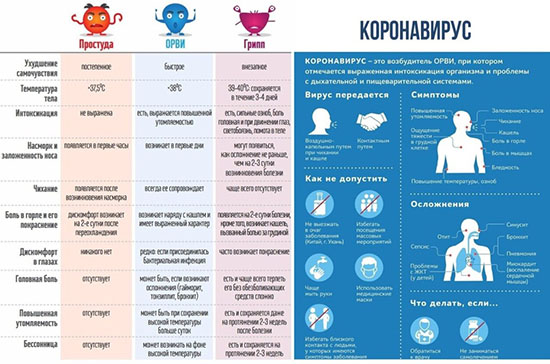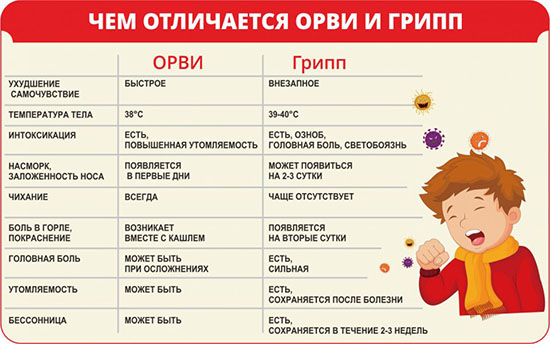At the beginning of 2020, the world learned about the emergence of a new coronavirus disease, which began to spread across China at an alarming rate. Just a few weeks later, the first cases appeared in countries neighboring China. In early March, the coronavirus spread to European countries. On March 11, 2020, WHO announced the recognition of the new 2019-nCoV virus as a pandemic, equating this disease to plague, smallpox, cholera, and Spanish flu.
As of March 20, 2020, 253 cases of infection with this disease were recorded in Russia, 1 elderly woman died in a Moscow clinic.

The symptoms of coronavirus infection in the early stages are very similar to those of the common flu. Signs of the disease include high fever and dry cough. The virus itself, like any coronavirus disease, primarily affects the patient's respiratory system. If timely measures are not taken to stabilize the condition of the sick person, he may even die.
Is coronavirus really a type of flu?
The coronavirus is actually a close relative of the flu, but those who believe that the coronavirus is no more dangerous than the flu are greatly mistaken. Both diseases are RNA-containing viruses and can actively mutate depending on the environment. This is what happened in China, when the virus was transmitted from animal to human, but in a modified and terrifying form. Coronavirus differs from the flu in a complex genome, it is difficult to fight it, it is difficult to find a remedy against it. But there is a cure for any disease, and vaccine trials are already underway.
The period of development of the disease in the human body is from 2 to 14 days, while the flu period of the disease can be measured in a matter of hours, from 4 to 72 hours from the moment of infection. Flu-like symptoms include fever, headache, dry cough, and heavy breathing.
Both viruses spread in the air, you can get infected even from a sneeze of a stranger, provided that the infected person is in the same room with him. At the same time, the infection rate of coronavirus is several times lower than that of the influenza virus. If the coronavirus spread at the same rate as the flu, then the number of infected people would be hundreds of times higher. Approximately 10 to 25% of the total population of the country, which within China would amount to hundreds of millions of people.

Coronavirus, like the flu virus, enters through the nasopharynx, so experts recommend wearing protective masks, drinking plenty of fluids and resting more.
What is the difference between diseases by symptoms
In the first 48 to 72 hours after contracting a coronavirus infection, a person experiences general signs of malaise. These symptoms include fever, fatigue, broken bones, drowsiness, shortness of breath, dry cough. The above symptoms are similar to those of the common flu. With a complex course of the disease, complications such as inflammation of the lungs and kidneys or kidney failure may appear.
The main difference between the coronavirus and the flu is the absence of a runny nose. The influenza virus affects only the upper respiratory tract, while the coronavirus only affects the lower ones.
The disease often affects sick or debilitated people, people suffering from lung diseases or the elderly. Mortality among young and healthy people is many times lower.
What is the difference between coronavirus and SARS
Coronavirus and SARS also have similar general signs of the disease. The same signs of fatigue, temperature, breaking in the bones. However, when infected with 2019-nCoV, there is a complex and rapid nature of the disease.
The main difference is the severity of the disease. If with SARS all the symptoms smoothly turn into one another, then with a new virus, events develop rapidly. Body temperature can jump sharply up to 39 - 40 degrees, and health will worsen in a matter of hours.

Although in both cases there is weakness, but with a coronavirus disease, the weakness is such that the patient cannot even raise his arm. There is no need to talk about any walking or even going to work.
Also, another hallmark is a dry cough. Dry and debilitating cough was observed in 70% of patients. With SARS, the cough is often wet and the patient expectorates a large amount of sputum from the lungs.
Similarities and differences with other viruses
This is not the first time humanity is facing the threat of a pandemic. With changing climatic conditions and adaptation of stamps to antibiotics, more and more new viral diseases appear. The constant struggle of virologists and scientists with allows to somehow contain the growing threat of extinction of mankind, but the forces are clearly not equal.
Ebola virus
An outbreak of the Ebola virus was recorded in 2014 in Africa and claimed the lives of more than 11 thousand people. The disease was transmitted exclusively through blood or food, therefore, in conditions of complete unsanitary conditions and hunger, it spread quite easily. The Ebola virus is dozens of times more dangerous and deadly than its successor, the mortality rate for infection with a new virus was 46%, with a total number of infected people of 28 thousand people.
The symptoms of Ebola include:
- Temperature;
- Headache;
- Breakage in the body;
- A sore throat;
- Rash;
- Sharp pain in the chest.
Rotavirus
According to official statistics, rotovirus mainly affects children from 0.5 to 5 years. Adults also get sick with it, but the signs are subtle and sluggish. The oldest of the sick patients is a 36-year-old man.

The main symptoms of rotovirus disease are nausea, vomiting and diarrhea. At the same time, the patient's temperature rises to 39.5 degrees, and the presence of blood or black clots is noted in the stool. The disease is transmitted through unwashed hands, contaminated food and water.
Every year, up to 400 thousand people die from rotovirus worldwide. Although scientists have already created an antiviral drug against it, the virus is insidious and not always amenable to early detection.
HIV
HIV-a infection in Russia alone annually claims thousands of lives, in 2017 alone more than 270 thousand people died, and as of 2019, more than 1.3 million infected people already. HIV infects the cells of the immune system and makes a person defenseless against any other diseases.
The virus is transmitted exclusively through blood or unprotected sexual contact, however, it has not been possible to stop it to this day. First of all, the people themselves are to blame for the spread of the virus, most of the infected are drug addicts or socially disadvantaged people. A vaccine against HIV has never been created, so the patient is placed under observation and takes life-long drugs that prolong his life. After stopping the drugs, a person usually dies in the next few months from liver damage or any viral and infectious disease.
HIV has nothing to do with coronavirus infection, although the latter is also spreading rapidly, despite the fact that it is not transmitted through the air.
What is more dangerous flu or coronavirus
Although the coronavirus is a type of flu, it is definitely more dangerous than the flu or SARS combined. Although the overall infection rate of 2019-nCoV is lower than that of the flu, the number of cases is still growing due to the fact that people simply do not have developed immunity to the disease. If the flu can be easily cured at home, the coronavirus requires mandatory isolation and treatment in a hospital.
The high incidence of coronavirus is also due to the fact that it easily enters the body from the air. It is enough to take a breath in a public place and it is safe to say that the infection has already begun.
Also, compared with the flu, the mortality rate from coronavirus is many times higher. if no more than 0.2% of those infected die from the flu, then up to 2.4% of those infected die from the coronavirus.
coronavirus is dangerous for the elderly and people with chronic lung diseases. Most deaths fall into this category, while young and healthy people die much less frequently.
The main danger is also the uncertainty of symptoms, people often think that they have the flu. At the same time, precious time is lost, which is necessary for treatment and symptomatic relief.